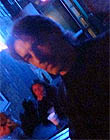|
|
This topic comprises 2 pages: 1 2
|
|
Author
|
Topic: Super Lumex Amps question
|
|
|
|
|
Randy Stankey
Film God

Posts: 6539
From: Erie, Pennsylvania
Registered: Jun 99
|
 posted 07-15-2011 07:54 AM
posted 07-15-2011 07:54 AM




Amps/current is a little bit of a moving target. There is a limit to how much current a lamp and a lamphouse can handle but you can't say that 90 amps or 100 amps is exactly correct for any given situation. Current will fluctuate within a certain range, even if you have a regulated (switching) power supply. With a switcher that range will be smaller, sometimes only an amp or two, but it can still fluctuate.
As Louis says, multiply amps * volts to get watts. Set the current so that your wattage is in the range you need.
Personally, I set my wattage to be around 90% of the lamp's rating but I sometimes pull that back to 85% and, if the lamp runs best at a hair bit over the rating (only by just a few watts) I'll go with that. Remember, running a lamp at 100% all the time is like driving a car with the engine at full throttle. Yes, your car can do it. It was designed to go that fast but, if you value your car, you won't run at full throttle all the time because it's not going to last as long. Same thing with a xenon lamp. Yes, it will run at full wattage but it will last longer if you take care of it and don't run it full-out all the time.
If you have a dark movie like Harry Potter and you need to brighten the picture, go ahead and throttle up if you have room but don't do it all the time unless you need to.
Other people do things differently but this way has served me well for 15 years and I rarely have trouble with xenon lamps or power supplies failing prematurely. I believe it's has a lot do do with the fact that I am conservative in the way I run things.
| IP: Logged
|
|
Scott Norwood
Film God

Posts: 8146
From: Boston, MA. USA (1774.21 miles northeast of Dallas)
Registered: Jun 99
|
 posted 07-15-2011 09:57 AM
posted 07-15-2011 09:57 AM





Everyone seems to have a different theory on this.
Mine is that bulbs tend to produce less light output over time, and that this is not desirable. Therefore, I tend to start new bulbs at somewhat less than the maximum current, and then raise it gradually over the life of the bulb.
For example, with an Osram XBO-2000W/H, I would generally run a brand-new bulb at 75 amps and would gradually increase that to 85 amps (the max) as the bulb ages. In theory, this should smooth out the change in light output over time. I have no proof of this, but I also believe that this approach reduces flicker. The exception to this would be in 2-machine booths, where lamp current needs to be adjusted to match the output on both projectors.
I currently do not rotate bulbs. In the past, I have seen no benefit to doing so, and have found that they often start to flicker when rotated (why?).
And, yes, I know that the stage lighting people tend to become apoplectic when people refer to "lamps" as "bulbs." Sorry.
| IP: Logged
|
|
|
|
|
|
|
|
|
|
|
|
|
|
|
|
|
|
|
|
|
|
|
|
|
|
All times are Central (GMT -6:00)
|
This topic comprises 2 pages: 1 2
|
Powered by Infopop Corporation
UBB.classicTM
6.3.1.2
The Film-Tech Forums are designed for various members related to the cinema industry to express their opinions, viewpoints and testimonials on various products, services and events based upon speculation, personal knowledge and factual information through use, therefore all views represented here allow no liability upon the publishers of this web site and the owners of said views assume no liability for any ill will resulting from these postings. The posts made here are for educational as well as entertainment purposes and as such anyone viewing this portion of the website must accept these views as statements of the author of that opinion
and agrees to release the authors from any and all liability.
|

 Home
Home
 Products
Products
 Store
Store
 Forum
Forum
 Warehouse
Warehouse
 Contact Us
Contact Us




 Printer-friendly view of this topic
Printer-friendly view of this topic









![[Wink]](wink.gif)

![[Big Grin]](biggrin.gif) )
)


![[Mad]](mad.gif) . The Technilight stuff works great. Just ask ayone that has one. Many have been installed for Tech. 3-D and have provided incredible results. I did one in a Strong Highlite console and the result was literally three times the light output of the stock reflector. The Technilight was also a bit LESS EXPENSIVE than a new stock reflector would have cost. There is a 6 screen drive in in SLC that converted all six Christie lamphouses to Technilite many years ago and their outdoor image is brighter than many indoor theaters image. In fact that entire Drive in chain which is based in Calif. converted all their screens over.
. The Technilight stuff works great. Just ask ayone that has one. Many have been installed for Tech. 3-D and have provided incredible results. I did one in a Strong Highlite console and the result was literally three times the light output of the stock reflector. The Technilight was also a bit LESS EXPENSIVE than a new stock reflector would have cost. There is a 6 screen drive in in SLC that converted all six Christie lamphouses to Technilite many years ago and their outdoor image is brighter than many indoor theaters image. In fact that entire Drive in chain which is based in Calif. converted all their screens over.




